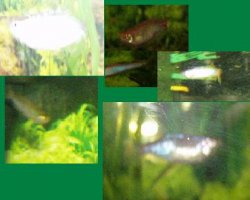Hi,
That whiteskirt tetra photo is SOOOOOOO adorable!!!!




Also,
I always hate to correct people because it sounds so b*tchy, but those are not boesemani rainbows. Boesemani's are these kind:
I only know because I found this GREAT site all about Rainbows and it took me FOREVER to find out which kind I have

)
But I think that this is what you have

) :
Common Name: Eastern Rainbowfish
Family: Melanotaeniidae
Scientific Name: Melanotaenia splendida splendida (Peters, 1866)
Other Names: Nematocentris splendida Peters, 1866; Strabo nigrofasciatus Kner & Steindachner, 1867; Aristeus fitzroyensis Castelnau, 1878; Aristeus rufescens Macleay, 1881; Melanotaenia nigrofasciata Ogilby, 1896; Rhombatractus fitzroyensis Ogilby, 1896; Rhombatractus rufescens Ogilby, 1896; M. s. splendida Allen, 1980.
Description: M.s.splendida display a great natural assortment of colours. Populations of almost every river system have their own distinctive body colour and pattern. Consequently, specific names usually based on the locality where each is found are used by aquarium enthusiasts to identify each variety. Males are more brightly coloured, larger, and much deeper bodied than females. Not easily distinguished from Melanotaenia splendida inornata. Principal differences are body depth, fin counts, and colour pattern, which is variable depending on location and water conditions. Scientifically described as Nemacentrus splendida in 1866. Gerald Allen's revision of the family Melanotaeniidae in 1980 placed them under their present name of Melanotaenia splendida splendida.
Distribution
Originally collected from around the Rockhampton area in central Queensland. Found in streams east of the Great Dividing Range along the coast of Queensland from Gladstone north to the Normanby River system in Cape York Peninsula.
Habitat
Occurring in almost every kind of freshwater habitat, from slow-moving streams, swamps, lakes and clear flowing rivers. They are frequently found in company with M. maccullochi, M. trifasciata, Cairnsichthys rhombosomoides, and Pseudomugil spp. Their natural environment is subjected to seasonal variations with water temperature (20-30°C), pH (5.0-8.5), and hardness levels varying considerably. They are usually found around sub-surface vegetation, submerged logs, or branches.
Brief Biology
Body slender and compressed but depth increasing with age. Two dorsal fins, very close together, the first much smaller than the second. Mature males have a higher first dorsal fin, which overlaps the origin of the second dorsal fin when depressed. Females have smaller rounded dorsal and anal fins. May reach a maximum size of 15 cm, but usually less than 10 cm. Spawning occurs from October to December, with females producing between 100 and 200 eggs, spawning a number of times daily for several days. Eggs adhere to water plants and hatching occurs after 6-7 days. Essentially a carnivore, feeding on a variety of terrestrial and aquatic insects, insect larvae, and small aquatic crustaceans. Aquatic algae and fallen plant pollens are also ingested.






































 lOOKS LIKE MY SONS ROOM .
lOOKS LIKE MY SONS ROOM . Have they beaten up you're fish at all? Those are beautiful
Have they beaten up you're fish at all? Those are beautiful 











 )
)
 /mike-edwardes.members.beeb.net/Mboesemani.html
/mike-edwardes.members.beeb.net/Mboesemani.html